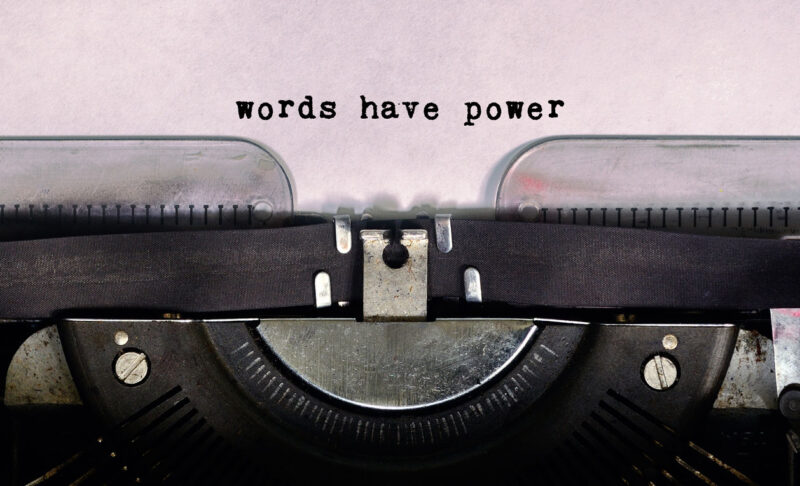Blog Short # 121: How Positive Language Helps Regulate Your Emotions

Photo by Cn0ra, Courtesy of iStock Photo
Positive thinking is in vogue right now, and whether you buy into it or not, there is some scientific backup for why using positive language and thinking is beneficial.
Today I’m going to summarize what the studies tell us and offer some ideas of how you can use this information to your benefit to regulate your emotions and navigate adverse events when they arise.
A quick caveat: I don’t believe you should ever suppress negative emotions. Let them rise, and allow yourself time to feel them out. But then, use a mindful approach to help you decide how best to respond.
Okay, let’s start with how negative language affects your brain.
Your Brain’s Negative Radar
When you hear and focus on negative words and thoughts, there’s an increase in the activity in your amygdala, which is the part of the brain that sounds the alarm for danger. It’s like the red alert on a spaceship.
When this happens, there’s a release of stress-producing hormones (like cortisol) that interfere with the functions of your thinking brain (the neocortex), where executive tasks like logic, analysis, impulse control, language processing, and communication take place.
In more impressive language:
“The more you stay focused on negative words and thoughts, the more you can actually damage key structures (in your brain) that regulate your memory, feelings, and emotions (Newberg & Waldman, 2012).”
It’s important to note that not only are more stress chemicals released in your brain when focused on negative content, but they’re also released in the brains of anyone listening to you.
Negative Thinking is Self-Perpetuating
Negative thinking leads to more negative thinking. The more you’re exposed to it, either your own or someone else’s, the more negative thoughts you’ll have. It takes on a life of its own, partly because we have a natural negativity bias which, when fed, will run rampant, and partly because of how the brain works.
When you engage in repetitious thought trains, your brain accommodates you by creating neural pathways to make it easier. And the more you do it, the more these pathways strengthen and become resistant to change.
So even if you try to increase your positive thoughts, your brain still defaults to the negative when you’re not consciously controlling where your mind goes.
The danger is that you can find yourself chronically focusing on everything that’s wrong without realizing you’re doing it. Your perception narrows to the degree that you miss what’s going right.
What we focus on snowballs because our brains are getting the signal that that’s where we want to go and stay. Neuron paths are helpful, but not if the captain isn’t aware of where he’s steering the ship.
Fearful Words Lead to Fight-Flight-or-Freeze
Words that bring on a “fear response” have special power because of the amygdala’s sensitivity to perceived danger. “Fear” words set us on edge and stimulate fear-laden fantasies.
They send us into fight-flight-or-freeze mode. You start ruminating and worrying about what’s ahead. You devise worst-case scenarios and anxiously create strategies to counteract what you think might happen, all the time fearing you won’t be able to handle it.
We’re worry machines. And worry can either catapult you into frenetic, uninformed actions with negative consequences or immobilize you so you take no action.
The Power of Hostile Language
Like fear-based words, hostile language has its own particular category of destruction. Studies have shown hostile language to disrupt the activity of specific genes involved in producing neurochemicals that protect us from physiological stress.
Children consistently exposed to hostile language growing up may be more susceptible to anxiety and depression as adults and have less capacity to fend them off.
The Neurological Power of Positive Language
Now comes an important recognition:
Our brains respond to our fantasies ( thoughts, ruminations, and words) as though they’re real, regardless of whether they’re positive or negative. And the harder we focus in a direction, the more power it has over our emotional status.
You can use this to your advantage. If you tip your focus toward the positive through repetitive thinking and language, your brain will help you counteract a bias toward negativity. That doesn’t mean denying or suppressing natural negative responses to painful situations: it means using your brain’s power to extract what you need from them, work them through, and then let them go.
Here are some specific benefits of using positive language.
1. It produces calm and relieves stress.
If you focus on positive words or images, the emotional centers in your brain (amygdala) calm down.
A study conducted by Herbert Benson’s team discovered that the “repetition of personally meaningful words can actually turn on stress-reducing genes” (Dusek et al., 2008). They had participants go through a short series of breathing and relaxation exercises followed by 20 minutes of repeating a word or short phrase associated with feelings of serenity, peacefulness, or joy.
Within eight weeks, there was an alteration of stress-reducing genetic expression. This process is similar to Transcendental Meditation, also researched by Herbert Benson.
Most interesting is that recent studies have shown that meditative exercises like the one above will increase the thickness of your neocortex and shrink the size of your amygdala.
2. Moves you toward taking action.
When you focus on a positive or optimistic thought, you stimulate activity in the frontal lobe where there’s a connection between specific language centers and the motor cortex that moves you to act (Newberg, Waldon, 2012).
In other words, positive self-talk helps you break out of emotional paralysis and take action.
3. Changes how you perceive yourself and others.
Other brain changes in the parietal lobe affect your perceptions of yourself and others with whom you interact. A positive orientation will lead you to see the good in others and yourself. Conversely, a negative self-image and orientation will lead to criticism, doubt, wariness, and seeing the worst in others.
How You Can Use This Information
Don’t suppress negative emotions. Take a mindful approach and observe without acting on them. Let them come up, feel them, and then step back and view them from a distance.
Next, consider options for action that will use your emotions to propel you where you want to go. Sometimes the action is simply shifting your attention to something more productive. Other times it may be seeing the hidden benefits of a negative experience. You may have learned a valuable lesson or had to pivot in a new direction.
Watch your language, especially words that promote fear, hostility, anger, and discord. We’ve become a very emotive culture and sling the f-bomb like it’s a love tap, but words carry a pulse of energy that shoots out and is felt by the receiver as well as by you. Be mindful of what you’re radiating with your words.
Try any and preferably all of these ideas:
- Do a gratitude journal daily.
- Start a meditation practice and stick with it.
- When you catch yourself ruminating or having a negative conversation in your head, stop yourself and ask if there’s some action you need to take or if you’re just complaining and need to refocus on something more productive.
- Google “positive words” and start expanding your positive vocabulary. Just reading over such a list will put you in a better mood.
- Monitor your consumption of negative media.
Last Thought
Positive and negative are two poles on the same continuum. You can’t have one without the other, but you can decide how to use them. Your brain will follow along with what you tell it. Just be sure you’re taking advantage of that power in your choice of words, thoughts, and actions.
That’s all for today.
Have a great week
All my best,
Barbara
FOOTNOTES
Dusek, J. A., Out, H. H., Wohlhueter, A. L., Bhasin, M, Zerbini, L. F., Joseph, M. G., Benson, H., & Libermann, T. A. (2008, July 2). Genomic counter-stress changes induced by the relaxation response. PLoS One, 3(7), e2576. DOI: 10.1371/journal.pone.0002576
Alia-Klein, N., Goldstein, R. Z., Tomasi, D., Zhang. L., Fagin-Jones, S., Telang, F., Wang, G. J., Fowler, J. S., & Volkow, N. D. (2007 Aug.). What is in a word? No versus yes differentially engage the lateral orbitofrontal cortex. Emotion 7(3), 649–59. DOI: 10.1037/1528-3542.7.3.649
Brummett B. H., Helms M. J., Dahlstrom W. G., & Siegler I. C. (2006 Dec). Prediction of all-cause mortality by the Minnesota Multiphasic Personality Inventory Optimism-Pessimism Scale scores: Study of a college sample during a 40-year follow-up period. Mayo Clinic Proceedings, 81(12), 1541–44. DOI: 10.4065/81.12.1541
Fossati, P., Hevenor, S. J., Graham, S. J., Grady, C., Keightley, M. L., Craik, F., & Mayberg, H. (2003 Nov). In search of the emotional self: An fMRI study using positive and negative emotional words. American Journal of Psychiatry, 160(11), 1938–45. DOI: 10.1176/appi.ajp.160.11.1938
Jirak, D., Menz ,M. M., Buccino, G., Borghi, A. M., & Binkofski, F. (2010 Sep). Grasping language—A short story on embodiment. Consciousness and Cognition,19(3), 711–20. DOI: 10.1016/j.concog.2010.06.020
Newberg, A. & Waldman, M. R. (2012). Words Can Change Your Brain. Penguin Publishing Group.
Seligman M. E., Steen T. A., Park, N., & Peterson, C. (2005 Jul-Aug) Positive psychology progress: empirical validation of interventions. American Psychologist, 60(5), 410–21. DOI: 10.1037/0003-066X.60.5.410








